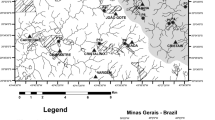Abstract
The distribution of 166 pesticides of various classes (amides, dinitroanilines, pyrethroids, thiocarbamates, triazines, etc.) was studied at 20 ± 1°C in multiple extraction systems. The distribution constants (P) of pesticides between hexane and a polar phase are calculated. Based on the distribution constants of pesticides, a possibility of using distribution chromatography for their identification was considered. It is demonstrated on an example of pesticides with similar retention times that the hexane–water extraction system is most selective and universal for the identification of most compounds by gas and liquid chromatography. Using this system, logarithms of distribution constants of the substances under consideration are maximally differentiated and ranged from–1.32 to 8.0. Such a range makes it possible, with an acceptable volume ratio of the hexane and water phases (up to 1: 500), to achieve a significant decrease in the peak area of the pesticide in hexane when it is washed with water in accordance with its P value up to logP = 3.0. In the case of more hydrophobic pesticides, extraction systems of hexane–ethylene glycol, hexane–acetonitrile, and hexane–mixtures of acetonitrile with water and ethylene glycol can be used.
Similar content being viewed by others
References
Berezkin, V.G., Loshchilova, V.D., Pankov, A.G., and Yagodovskii, V.D., Khromato-raspredelitel’nyi metod (distribution Chromatography Method), Moscow: Nauka, 1976.
Zenkevich, I.G. and Vasil’ev, A.V., Zh. Anal. Khim., 1993, vol. 48, no. 3, p.473.
Arutyunov, Yu.I., Onuchak, L.A., Vavrushko, V.V., and Mikhailov, I.Yu., Vestn. Samar. Gos. Univ., Estestvennonauchn. Ser., 2014, no. 3(114), p.136.
High Resolution Gas Chromatography, Hyver, K.J., Ed., Hewlett-Packard, 1989.
Picó, Y., Font, G., Ruiz, M.J., and Fernández, M., Mass. Spectrom. Rev., 2006, vol. 25, p.917.
European Standard EN 15662:2008 (E): Foods of Plant Origin. Determination of Pesticide Residues Using GC–MS and/or LC–MS/MS Following Acetonitrile Extraction/distributioning and Clean-up by Dispersive SPE–QUEChERS Method, 2008.
Wilkowska, A. and Biziuk, M., Food Chem., 2011, vol. 125, p.803.
Ferrer, C., Gómez, M.J., García-Reyes, J.F., Ferrer, I., Thurman, E.M., Fernández-Alba, A.R., J. Chromatogr. A, 2005, vol. 1069, p.183.
Zayats, M.F., Leschev, S.M., Petrashkevich, N.V., Zayats, M.A., Kadenczki, L., Szitás, R., Szemán Dobrik, H., and Keresztény, N., Anal. Chim. Acta, 2013, vol. 774, p.33.
Zayats, M.F., Leschev, S.M., and Zayats, M.A., Anal. Chem. Res., 2015, vol. 3, p.37.
Zayats, M.F., Leschev, S.M., and Zayats, M.A., Food Addit. Contam., 2016, vol. 33, p. 1337.
Leschev, S.M., Regularities of extraction in systems on the basis of polar organic solvents and use of such systems for separation of important hydrophobic substances, in Ion Exchange and Solvent Extraction: A Series of Advances, Marcus, Y. and SenGupta, A.K., Eds., New York: Marcel Dekker, 2001, vol. 15, p.295.
Leschev, S.M., Bunevich, N.V., and Shulyakovskaya, O.V., Proc. Natl. Acad. Sci. Belarus, Ser. Chem. Sci., 2012, no. 1, p.47.
Commission Regulation (EU) 2016/67 of 19 January 2016 amending Annexes II, III, and V to Regulation (EC) no. 396/2005 of the European Parliament and of the Council as regards maximum residue levels for ametoctradin, chlorothalonil, diphenylamine, flonicamid, fluazinam, fluoxastrobin, halauxifen-methyl, propamocarb, prothioconazole, thiacloprid and trifloxystrobin in or on certain products (Text with EEA relevance), Off. J. Eur. Union, 2016, L15/2, vol. 59, p.33.
Zayats, M.F., Zayats, M.A., Leschev, S.M., and Petrashkevich, N.V., Proc. Natl. Acad. Sci. Belarus, Ser. Chem. Sci., 2015, no. 3, p.27.
Zayats, M.F., Proc. Natl. Acad. Sci. Belarus, Ser. Chem. Sci., 2017, no. 1, p.57.
Leschev, S.M. and Zayats, M.F., Russ. J. Phys. Chem. A, 2012, vol. 86, no. 6, p. 965.
Author information
Authors and Affiliations
Corresponding author
Additional information
Original Russian Text © M.F. Zayats, S.M. Leschev, 2018, published in Zhurnal Analiticheskoi Khimii, 2018, Vol. 73, No. 5, pp. 377–388.
Rights and permissions
About this article
Cite this article
Zayats, M.F., Leschev, S.M. A Distribution Chromatography Method for the Identification of Pesticides in Their Mixtures and Agricultural Products. J Anal Chem 73, 486–496 (2018). https://doi.org/10.1134/S1061934818050143
Received:
Accepted:
Published:
Issue Date:
DOI: https://doi.org/10.1134/S1061934818050143




